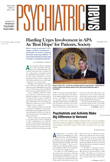Is there anything more boring than an organization’s budget? Row upon row, column after column of numbers fill the pages. Revenues logged on a cash basis differ from those recorded on an accrual basis. Operating budgets, capital budgets, balance sheets, and the like each convey a view of an organization’s fiscal health, but it is not always easy to see the whole picture. Interpreting a budget is an arcane art form, as those of you who have tried are well aware. But fail to pay attention to those numbers and the consequence can be an organization’s demise—as all-too-familiar examples from the business world painfully demonstrate.
Things are no different for APA. Everything we do for our patients and our members depends on managing our budget in a responsible way. And that has gotten increasingly difficult to do in recent years, as expenses have increased at or beyond the rate of inflation, while revenues have lagged. Dues have been held constant for six years now, an important statement to our members as they undergo fiscal stress themselves, but a challenge for our budget makers, who need to look elsewhere to make up the difference. Moreover, there has been a decline in membership over the past few years, though thankfully not as steep as for some other medical organizations. A plunging and now static stock market has reduced our investment income. And we have been hit by some of the unpredictable events of the business world, like the bankruptcy of a major book distributor that handled our publications.
Like any other entity (except, it seems, our federal government), APA needs to live within its resources. When dollars are tight—as they are right now—we need to reduce costs and prioritize our efforts. There are few things that we do that aren’t worth doing. But with too few dollars to go around, we need to focus on our priority areas and put other initiatives aside—perhaps not forever, but at least for now. This is precisely what we’re doing, and I would like to share with you the planning that is now in progress to accomplish it.
First, we are reducing the costs of carrying out our day-to-day activities. The impending move of APA headquarters across the Potomac to a beautiful building in Rosslyn, Va., will save us roughly $800,000 a year over our current rent. At its June meeting, the Board of Trustees will be considering a plan for reorganizing the APA offices to increase functionality and reduce costs. The plan is being proposed by the Task Force on Long-Range Financial and Budget Planning, which was appointed by my predecessor, Richard Harding, M.D., and which I have been pleased to chair. After meeting with all APA division directors to identify the tasks that their offices perform, the task force is prepared to work with the Finance and Budget Committee to identify cost reductions for the 2003 APA budget. Of course, reducing costs inevitably means cutting back on programs that some—perhaps many—members believe are important. But to get to a balanced budget, we have no other choice.
Second, we have reconceptualized how our member-based components carry out their tasks. These councils, committees, and task forces do some of the most important work of the Association, and they have been an important locus for member involvement. The position statements, task force reports, resource documents, practice guidelines, and other products of APA emanate from these groups. When times were good, there was a tendency to set up a component to address every issue of concern, but that is no longer a sustainable strategy. Thus, Dr. Harding also appointed the Task Force on Component Reorganization, chaired by Marcia Goin, M.D., and Jon Gudeman, M.D., to rethink how our components do their work. The reorganization plan that they developed was adopted by the Board in March. It emphasizes giving more authority to 13 councils that will oversee broad areas of interest. Whenever possible, committees were converted to corresponding committees, which will meet in person at the annual meeting each year, but will otherwise do their work by conference call and e-mail. The estimated cost savings from this plan are approximately $700,000 a year.
Finally, the Long-Range Planning Task Force has initiated a process of examining our governance structure. Member governance of APA is critical, and the Board, with its fiduciary responsibilities, and the Assembly, with its ability to initiate actions and its deliberative capacity, provide a balanced governance structure. But are we governing ourselves as efficiently and effectively as we can? The task force suggested in an interim report that we may not be. Does the Board need 21 voting members, plus close to that number of nonvoting members sitting around the table? Does the Assembly need roughly 250 people at its meetings? Might both these structures operate more effectively—not to mention more economically—with reduced numbers? Both Assembly and Board will be considering the answer to these questions in the coming months.
Times of fiscal strain are difficult times, but—without wanting to sound Pollyannaish—they are also times of opportunity. In cutting back on some of the expenses we began to incur when times were good, we have a chance to shape a trimmer and more effective APA for the 21st century. ▪

